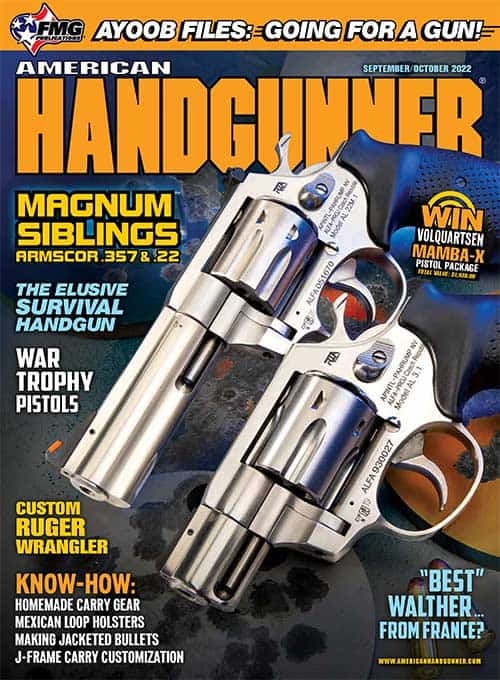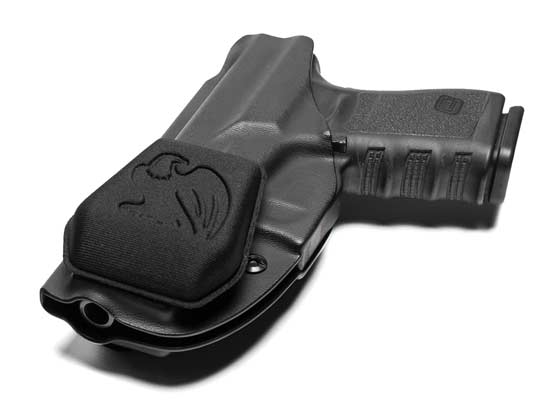Vantage Point: The French Do Something Right
French military jokes tend to write themselves, and somehow, French arms haven’t always enjoyed the satisfaction of a durable martial reputation.
So, let’s go ahead and get this out of the way so we can proceed to the story at hand … Do you know why French tanks are designed with one forward and five reverse gears? In case they have to retreat straight ahead. Ba-da-bing!
Now I’ve gotten it out of my system; it’s time to heap some well-deserved praise on a French arms maker.
Concealed Carry?
It was 2004, and my wife was looking for a concealed carry pistol. After handing a dozen or so carry candidates, one savvy gun store associate did the thoughtful chin squeeze with his index finger and thumb and retrieved an aged, rust-colored, snake-skin-textured box from a lower shelf. Faint silver-blue writing in a decidedly 1950s artistic style was barely readable. We made out the following.
Pistolet Walther PP. Fabri. Manufacture de Machines du Haut-Rhin. Mulhouse-Bourtzwiller (France) While the rest was French to me — I did receive a hard-earned “F” in septième-grade Francais — I recognized the critical word — Walther. French or not, my head immediately swelled with the thought of my wife carrying the preferred sidearm of celluloid super spies. At $350, it accompanied us home.
Manurhin Walther
As the story goes, Fritz, and other Walther family members, escaped the red wave to France at the end of WWII, carrying precious design drawings, including that of the proven PP model first introduced in 1929.
Nerves were a bit raw after World War II and Allied powers forbade the manufacture of arms by Germany for years after. In 1952, Walther officially licensed the manufacture of the PP model to the French firm to avoid those pesky post-war arms policies. The French company continued to make PP pistols until 1986.
Many pistols, such as the one shown here, were made entirely in France by French workers and QC inspectors. Others with Walther markings made the journey from steel stock to finished gun with partial manufacture in France, followed by “Walther” roll marking, slide hardening, final assembly and proofing in Germany right across the border. German law allowed for early production tasks in France provided critical final steps were completed in Germany.
This real history does throw a wrench in one of our most cherished hero myths. In the 1958 book and 1962 movie, Dr. No, secret agent 007 James Bond is issued a new pistol more worthy of his toxic masculinity — a Walther PPK. As MI armorer Major Boothroyd delivers the new sidearm, he notes, “Walther PPK, 7.65 mm, with a delivery like a brick through a plate-glass window. The American CIA swear by them.” Here’s the twist. Given the timing, James Bond’s iconic handgun would have been made (or at least mostly manufactured) in France. Dampens the mystique a bit, doesn’t it?
PP Precision
This gun is beautifully manufactured — among the finest in my safe right now. Fit and finish are spot-on throughout. Parts interoperate as they should, like the proverbial well-oiled machine. Slide shake? Zippo. The polish on flat areas is mirror-like. Bluing? On the day we brought it home, it could have passed for new-in-box condition. It’s very clear skilled hands worked on this little .32-caliber pistol, as the attention to detail is impressive. Compared to a decades-newer Interarms PPK I picked up years later, this one has the custom shop treatment.
One has to do some serious digging to learn the history of pre- and post-war Walthers and Manurhins. Based on the serial number, I did manage to figure out that mine (notice how I’m not referring to it as my wife’s?) was made in 1962 or 1963.
Modern & Classic Features
Arguably ushering in the long-lived trend of the single/double-action design, the PP operates with a heavy (somewhere in the 10- to 12-lb. range) double-action trigger pull. Just as with modern designs like SIGs, Berettas and others, that’s by design to provide a “revolver-like” margin of safety for that first shot. Of course, after round one, the system transitions to single-action operation. The well-rounded and polished trigger on this sample breaks cleanly at 4 lbs. after a quarter-inch of slick and friction-free take-up.
There’s no true safety, but rather a decocker lever on the left side of the frame. Like a Beretta 92-style pistol, this lever lives in the gray area between a decocker only and mechanical safety. Activating it drops the hammer safety, placing the PP back into double-action mode. However, it also interrupts the trigger and hammer movement, effectively preventing firing. The slide is fully operational with the decocker engaged.
If you haven’t field stripped a blowback PP or PPK, you’re in for a treat of elegant design — no extraneous levers required. Just pull down on the trigger guard (it’s hinged), retract the slide a bit and lift the rear of the slide to disengage it from the frame. The slide glides off the muzzle end, allowing you to remove the recoil spring from the fixed barrel.
The controls are old school, although not entirely European. The sights are minuscule, but there is a beautifully textured stripe on the top of the slide between the front and rear sights to eliminate glare. As for the magazine release, Walther bypassed that icky grip heel design and placed a proper button on the frame accessible by the firing hand thumb.
In its native 7.62 (.32 ACP) chambering, this pistol is a joy to shoot. Even with modern ammunition, it doesn’t really “have a delivery like a brick through a plate-glass window,” but shooter confidence and shot placement do count for something.
For a 1929 design of a 59-year-old French pistol, this one has been quite a fine investment, now serving as a fun range gun and future family heirloom.










